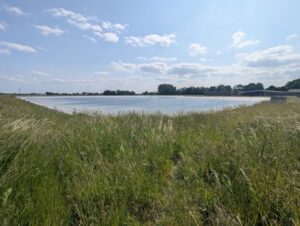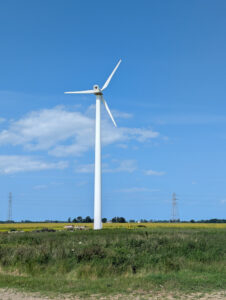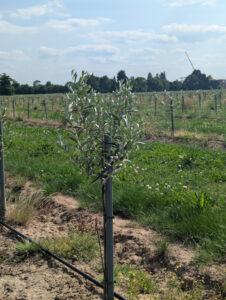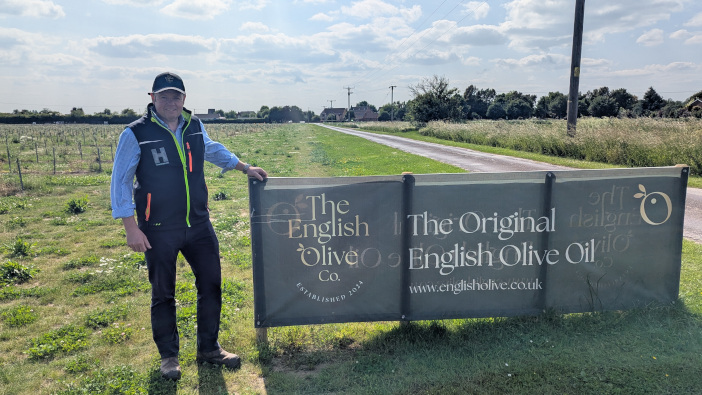Close attention to data has not only boosted arable yields on one Lincolnshire farm, but has also opened opportunities for diversification.
When you look at the website for GH Hoyles Ltd, you see a lot of space dedicated to the farm’s environmental projects. These include water management, renewable energy sources and biodiversity plots. You would assume that this leads quite naturally to regenerative farming measures, such as reducing tillage or direct drilling, yet farm director David Hoyle corrects us on this.
“We farm intensively, alongside nature,” he says. “Our ground is primarily on silt, which lacks structure and needs cultivating to put oxygen back into the soil.”
He continues that the carbon footprint of growing a high-yielding crop over a small area – the farm has multiple Yield Enhancement Network (YEN) Awards – is smaller than growing a low or medium-yielding crop over a large area.
“By utilising every tool at our disposal to get the best possible yields, we have reduced our total nitrogen per tonne and the horsepower per tonne of crop,” David adds.
Set over 700ha of mostly reclaimed Lincolnshire ground, the farm has a diverse rotation. Wheat averages at around 12t/ha, with 65% of it grown for seed and the rest grown as feed wheat; with vining peas handled by Holbeach Marsh Cooperative and achieving 8t/ha, sugar beet grown for the Wissington factory at 90t/ha, Maris Pipper, Lanorma and Markies potatoes grown for Nene Potatoes and yielding at 50t/ha, and Mustard crops for Colmans, which achieves around 1.6t/ha.
When it comes to the crops, investment has focused on vertical integration. GH Hoyles is set up with a cleaning and drying plant for its mustard, ensuring that it meets specification and providing an additional income stream by processing crops from other growers. For potatoes, 4,500t of fridge storage has been constructed, alongside 1,000t of ambient storage to maintain quality until it is transported off-site.
 The right tools
The right tools
Farming intensively does not mean that the business has remained behind the curve when it comes to technology. David notes that they were early adopters of precision equipment, and now use variable rate systems for seed, fertiliser and plant growth regulators.
The Omnia Plant Vision is mounted onto the Knight 36m sprayer to measure biomass at different points of the growing season, and all the farm’s data is collected into the Omnia system to monitor operations, create application maps and keep on top of costs per field, crop and hectare.
“It’s taken a long time for this information to build up,” David says. “And longer for us to find ways to generate a return from it, but now we’re able to use that data to be more agile with our decision making.”
The close eye on data means that David can budget effectively for the coming year but make on-the-spot decisions when external factors, such as the weather, affect these plans. As an example, he looks to wheat. He says that the farm’s yields are around 30% more than the national average, and on any given year he budgets for 12t/ha. Last year, the record-breaking rainfall and a 19% reduction in sunlight hours brought yields down to 9.5t/ha, the lowest since David joined the business.
“Having that data in front of me, backed up by tracking rainfall and sunlight, means that we can predict, with some accuracy, how yields are going to be affected. Then we look for solutions to counteract that loss of income,” he says. “It could be as simple as renting out stores that will not be required that year”
Recognising the need for information that works at a regional and on-farm level, rather than national trials, David has also worked with an agronomy group within South Lincolnshire Rural Training to run independent nitrogen trials. His plots are looking at fertility after vegetable crops and the requirements of second wheats, with nitrogen rates set between 0-400kg/ha, with sulphur added in certain plots to monitor nutrient uptake and crop response.
Data and nature
Monitoring the rainfall and sunlight hours available to the crop has informed decisions on rainwater management and renewable energy on the farm. In 2011, when the feed-in tariffs were at their highest, the farm installed its first set of rooftop panels, with more added in 2014 and 2023. The total power generated is around 200kW. This is backed up with a 100kW wind turbine, with the combination creating around 70% of the business’ electricity needs.
“They complement each other because peak power production is at different times of the year,” David says. “As the sunlight hours start to reduce in the autumn, the wind generally picks up and the wind turbine becomes the main source of power until the spring.”
Water management is key to the business as well, with potatoes and sugar beet making up a substantial part of the rotation. Two abstraction licences are used, with soil probes and drip irrigation booms used to minimise how much water is taken out. Alongside these, there are three reservoirs throughout the 700ha farmland, collecting excess water from the farm through a series of ditches and drainage systems, and from neighbours during peak rainfall periods.
GH Hoyles can store around 180,000cu m of water across the reservoirs. David explains: “The amount of water required to grow a crop, with the various applications, is immense, but it does protect us during the worst periods of rain and allows us to continue working when there is a drought.”
 Maximising inputs
Maximising inputs
One of the key benefits of utilising farm data has been the ability to focus efforts and costs onto high yielding area, while finding new ways to create income from low yielding areas. “The cost of production system within Omnia highlighted areas, and some cases whole fields, where we were never going to get a profitable crop. Areas where the rest of the farm was boosting the average to hide the overall cost,” David says.
Fields were squared with biodiversity and bird feed mixes to limit some of these areas, while in potato crops the tramlines have been widened to enable David to fit wider 600mm tyres. This reduced the cropped area by around 5% but with less crop damage and more sunlight for the crop rows, there has been no loss in yield.
In cases where areas of fields have been found to be unprofitable, the business has looked at diversification options, the first of which was the Fenland Dog Park. This recreational ground allows people to book one-hour slots and run their dogs around a fully fenced, private field.
“The field area was low lying, with no drainage, and was our most unproductive field,” David says. “Our original idea was to put in a farm shop and electric car chargers, alongside the dog walking park, and create a local hub. However, we couldn’t get planning for all that, so we opted for a change of land use and put in the dog park, with the hope that we can integrate other ideas later.”
The online booking makes the dog park relatively hands off, with only some maintenance for the grass and the 60m wildflower buffer strips. The only machinery investment has been a Kubota F251 ride-on mower, and the opening hours are adapted across the year so that the site is only open during daylight hours.
“Our farm is the priority,” David says. “But this has been a huge success for us. It’s run as a separate business to the farm and is earning up to £12,000/ha, compared to the loss the field was running at as agricultural land.”
It also provided the first direct-to-consumer business venture for the farm, which has informed the latest diversification as the UK’s first commercial-scale olive grove. Over a 10ha plot, 18,000 olive trees were planted in spring 2024, with multiple varieties to find the best plants suited to UK conditions.
“It was originally going to be a vineyard, but our research quickly showed that we did not have the correct soil type,” David says. “I assumed it would be the same for olives, but we found varieties that could thrive on our ground.”
 Whereas David has been able to use existing trials and Omnia data to inform his arable operations, the move to olives has been a jump into the dark. Andrew Houseman at Drip UK heled set up a fertigation system and James Hudson, of JF Hudson, helped source the planter to speed up the establishment process.
Whereas David has been able to use existing trials and Omnia data to inform his arable operations, the move to olives has been a jump into the dark. Andrew Houseman at Drip UK heled set up a fertigation system and James Hudson, of JF Hudson, helped source the planter to speed up the establishment process.
Since then, David has had to rely on his own research. Examining each of the varieties during the pruning process to assess which ones are doing well in the very un-Mediterranean climate of South Lincolnshire. It’s also been a new step for the business’ marketing, with The English Olive Co. already setup and taking orders for home gifts ahead of the first harvest in 2027.
“Selling direct has helped to offset some of the setup costs and build interest in English-grown olive oil ahead of the launch,” he notes. “It’s been a huge investment, but a lot of the initial costs are one-offs, and if all goes well, olive yields can double year-on-year until the plants reach maturity.”
A passion for growing
The initial harvest will be done by hand, using labour brought across from local fruit and vegetable farms, but as the yield increases David notes that he is looking at mechanisation. Similarly, while a small building and press is being installed to handle the first orders of olive oil, as the number of olives increases, this will also be expanded.
While the high-profile diversification options have certainly drawn attention to GH Hoyles, David says that the farm remains the focus, and each additional operation is handled in the same way, paying attention to data and an understanding of the basics.
“We’re a business, and our aim is to be profitable,” he says. “These new opportunities help us to continue to farm and add value to what we are already doing. The climate is changing and we can either struggle to do what we’ve always done, or we can look at our cropping and find solutions.”



